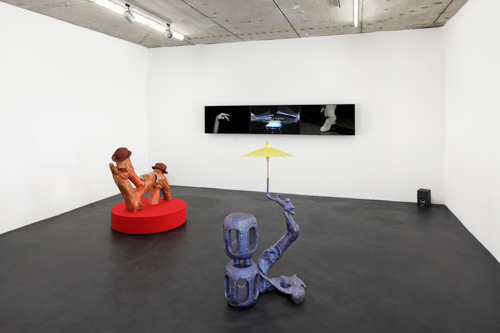Guan Xiao
Kraupa-Tuskany Zeidler
Kraupa-Tuskany Zeidler

Xiao’s exhibition Something happened like never happened, is a buoyantly humorous piece that offers brilliant artistic commentary on the daily madness that has come to surround the masterpieces in the world’s largest and busiest museums. David is about Michelangelo’s eponymous statue (1501–04) which is displayed at the Accademia di Belle Arti in Florence, but it is also about the countless copies and reproductions of the scupture that one encounters all around Florence.
Guan draws on a variety of online video material in her work: from professional tourism ads to amateur recordings, video selfies to merchandise – the whole cloud of souvenir tat that has come to envelop this showpiece of Renaissance art. The original statue is now buried so deeply beneath reproduction kitsch that it is safe to assume the original-copy discourse can be forgotten. ‘We don’t know how to see him’, the artist sings at one point on the video soundtrack. This reproduction blindness currently appears to be irreversible. This also means that in the case of certain mass-reproduced artworks, we have forgotten how to marvel at the work, which in turn places even more focus on commercialized interaction with general cultural assets. But David also shows that this is no cause for becoming culturally pessimistic. The fact that Guan renders her cultural criticism in a Chinese-karaoke, G-funk style that plays on the letters of the name David (‘D is for Disappear’, ‘A is for Appear’, ‘V is for Value’, ‘I is for Invisible’) gives the whole thing a laid-back feel.
Three quirky, coloured bronze sculptures in lovely root-carving-like forms that insist on their oddness (Rolling Beating, Moving Mountains, Slight Dizzy, all 2014) suggest the humourous bent to the artist’s work. The artist gives these shapes, which are made in part by hand, an almost figural quality by adding humanistic touches such as a little straw hat or an oversized cocktail umbrella. At the same time, the works conjure all the formal and cultural connotations of wood carving: DaWanda coffee tables, 1950s lamp stands, S-class dashboards with wood grain trim. Everything about these sculptures appears to be too much: too big, too heavy, too colourful, perhaps even too funny. In the context of the exhibition, they function above all as counterpoints to the rigorously composed videos.
Action (2014), the exhibition’s third video besides David and Reading (2013), hinges on the rhythmized connection between image and sound. The ten-minute work is a manifesto of sorts in which Guan elaborates the fundamental role of rhythm in her artistic practice: ‘For me, rhythm means all the intersections of sense’, Guan says in a commentary on the work. ‘It’s a way I understand the associations between things. It helps me to try and transfer action, see, listen, think about interactions and freely build a link between them.’ Action begins with footage from Andy Warhol’s underground classic Vinyl (1965); the sound of minimal drumming and image sequences then gather pace. As with David, Guan juxtaposes video clips found online with text over three screens, cut in the style of a music video: drummers, dancers, dancing elks – arms wide open to the world.
The video ends, however, with an animated ‘brand message’ from the Sony corporation: ‘make.believe’. The phrase suddenly calls into question whether this emphatically contemporary video is in fact a sort of clever marketing message (given the connotation of make-believe as pretending). This might just be a small nod to the electronics giant that gave everyday life a new rhythm with its introduction of the Walkman in 1979 but has been in decline since the rise of Apple. Perhaps seeking this ‘uncool’ association within a slick digital aesthetic is comparable to looking into a rear-view mirror at a landscape that one is rapidly leaving behind.
Translated by Jane Yager















